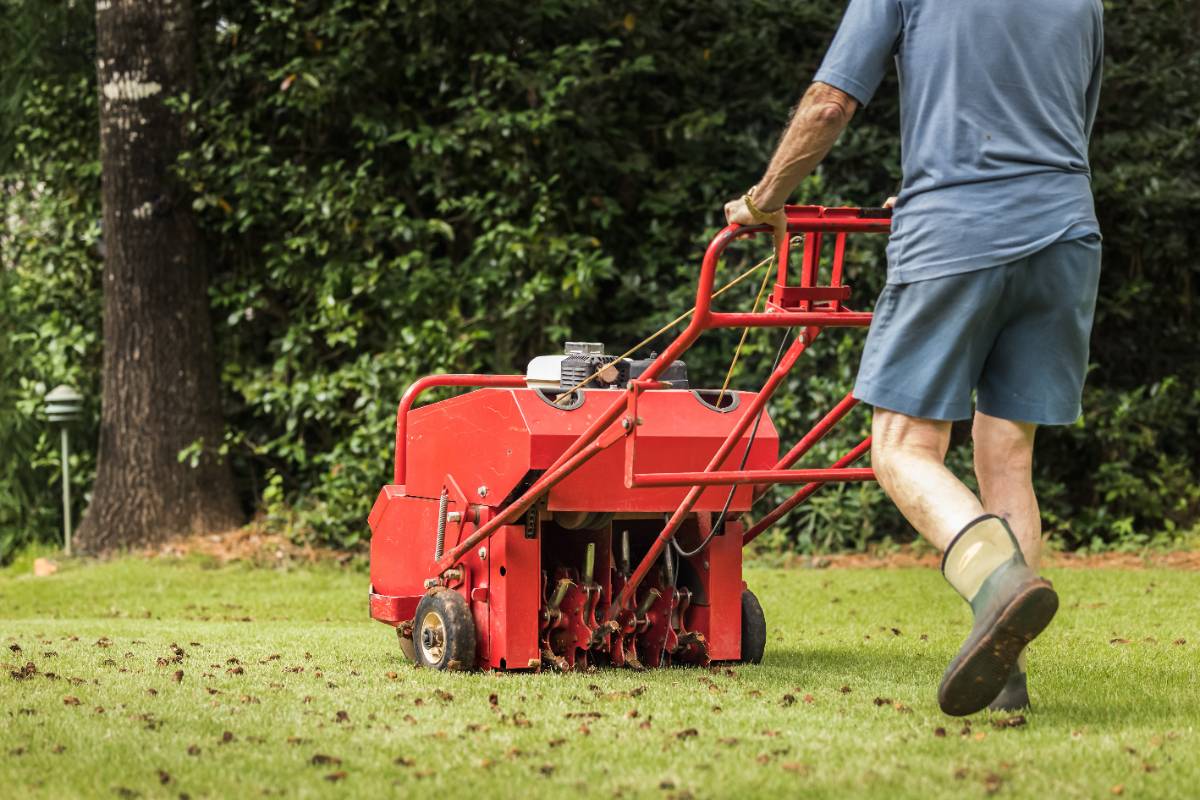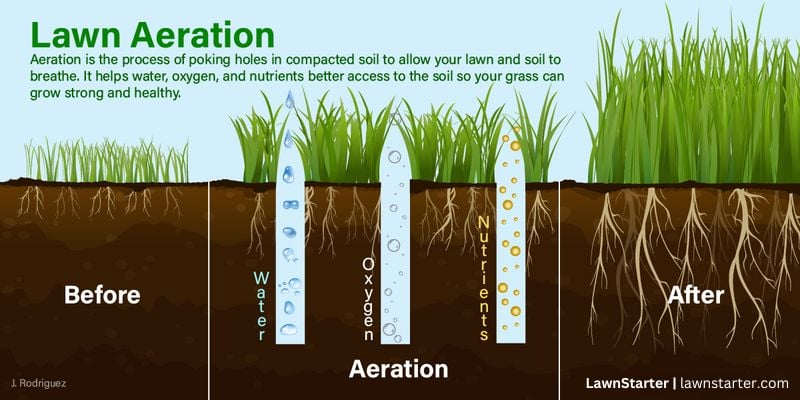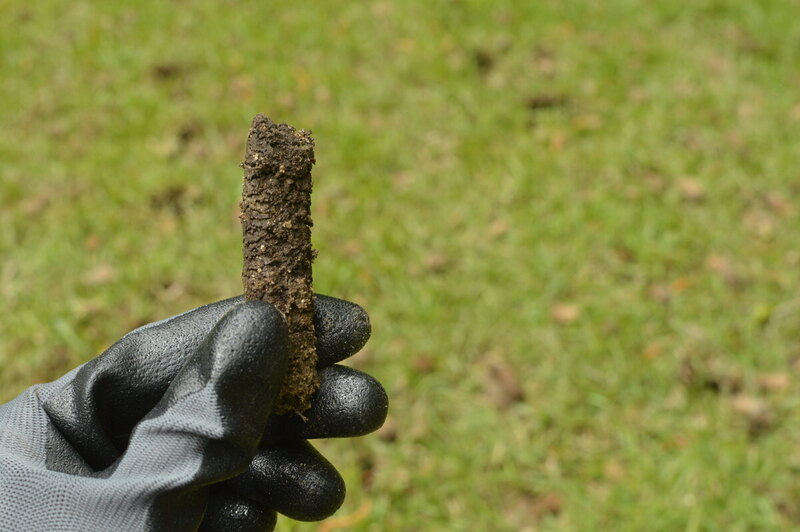
Frequent foot traffic or heavy equipment on your lawn can cause compacted soil. Core aeration is the process of removing small soil plugs from your lawn to help alleviate soil compaction.
Soil compaction causes problems for your lawn by preventing oxygen, nutrients, and water from entering the soil. In this guide, learn what core aeration is and what aerating does for your lawn by improving plant health and preventing erosion problems in your yard.
How Core Aeration Works

Core aeration, also known as plug aeration, is the process of using a machine to remove 2-inch to 4-inch soil plugs from your lawn. These plugs are left behind to break down and enrich the soil, while the holes improve airflow, water, and nutrient penetration for stronger grass growth.
Core aeration is the most popular method of aeration — spike aeration and liquid aeration being the other methods. Core aeration is preferred by lawn experts because it removes plugs of soil from the lawn, promoting healthier, thicker grass and preventing patchy, thin, and yellow turf.
For core aeration, you’ll need a core aerator, a tool that can be manual or motorized. This device uses hollow tines to pull out small plugs of soil, typically about 1/2 to 3/4 inches in diameter, 2 to 4 inches deep, and about 2 to 6 inches apart.
Here’s a quick summary of how to core aerate your lawn:
- Start by watering and mowing your grass 2 days before you aerate.
- Remove any obstacles like rocks, toys, or garden decorations from your lawn.
- Run your core aerator in one direction until you cover the entire area.
- Once you finish the first pass, go back and make a second pass perpendicular to the first. This helps ensure every part of your lawn gets the aeration it needs.
Tip: To grow a lush lawn, combine core aeration with overseeding and topdressing for better results. The holes left in the soil after aerating let new seeds settle in and connect better with the ground, making it easier for them to sprout. Also, those holes are perfect for soil amendments like compost to infiltrate and improve your soil.
See Related:
Why Your Lawn Needs Core Aeration

Here’s why you should aerate your lawn:
- Relieves soil compaction: Over time, heavy foot traffic, lawn mowers, and even your pets can compact the soil in your yard. Certain soil types, like clay or silty soils, are especially prone to compaction.
- Enhances air and water exchange: Aerating your lawn opens pathways for air, water, and nutrients to reach the roots, encouraging deeper root growth and healthier, greener grass.
- Helps in thatch control: Core aeration can make it easier to manage thatch (a layer of grass and organic matter that can build up on the soil surface), which helps further improve your lawn’s ability to absorb water and nutrients.
- Prevents pooling and stormwater runoff: By loosening compacted soil, core aeration allows water to penetrate the ground instead of collecting on the surface or running off.
- Increased drought resistance: Loosened soil and stronger roots mean your lawn is better equipped to withstand dry conditions.
- Reduces erosion risk: Aerating your lawn improves soil structure, which helps keep your soil in place and minimizes yard erosion over time.
- Improves fertilizer uptake: Most lawns require some fertilizer to thrive. By fixing compacted soil, aerating allows fertilizer to flow into the soil.
Tip: Core aeration is something you can DIY (you’ll need to rent a yard aerator), or you can hire a lawn care service to do this for you. LawnStarter offers core aeration by local pros across the U.S.
See Related:
- How to Tell You Have Compacted Soil
- Benefits of Aerating Your Lawn
- How to Prevent Thatch in Your Lawn
Signs Your Lawn Needs Core Aeration
Watch out for these signs that your lawn needs aerating:
- Poor drainage
- Excessive thatch buildup
- Yellowing or thinning grass
- Compacted soil
- Ruts caused by heavy equipment
- Pooling water
- Weeds
- Lawn diseases
- Lawn pest infestation
See Related:
When and How Often to Core Aerate

When you aerate depends on the type of grass you have:
- For cool-season grasses, the best time to core aerate is late summer or early fall. This gives your grass a chance to recover, and you can overseed to fill in bare spots before winter arrives.
- For warm-season grasses, you’ll want to core aerate in late spring or early summer when your grass is actively growing. This way, with the right fertilizer, grass will bounce back quickly after lawn aeration.
As a rule of thumb, most homeowners should aerate their lawns once a year. You might need to aerate twice a year if you notice signs of compacted soil. The type of soil and level of activity are key factors for how often you’ll need to aerate.
“Lawns growing in heavy, clay soils and those subject to heavy foot or pet traffic should be aerated twice a year. Once a year should be sufficient for lawns that are established on well-drained soils and experience little traffic,” says Richard Jauron, retired Extension horticulturist at Iowa State University.
See Related: Best Time to Aerate and Overseed Your Lawn
FAQ About Core Aeration
Yes, you can rent an aerator from a local home improvement or machine rental store and aerate your yard yourself. However, using the equipment incorrectly may lead to uneven results or even harm your grass. If you’d prefer to avoid DIY aeration, hire a professional to aerate your lawn instead.
Core aeration is the method recommended by most experts, but it’s not the only option:
• Spike aeration: Unlike core aeration, spike aeration pokes holes in the soil without removing any plugs. It’s a simpler process, but by pushing soil deeper into the ground, it can create more compaction around the holes rather than reducing compaction.
• Liquid aeration: In contrast, liquid aeration uses a chemical solution to loosen compacted soil. Like spike aeration, it doesn’t leave any soil plugs on your lawn and is typically easier to apply over larger areas. However, its effectiveness is debatable. (Learn more in our article: Does Liquid Lawn Aeration Work?)
The cost of core aeration varies based on factors like the size of your lawn and where you live. For an average-sized lawn, core aeration services cost $107 to $202. Typically, renting a core aerator for a DIY job costs $100 per day with a refundable deposit of $75 to $150.
Aerate Your Lawn Today
Soil compaction can be a serious problem for your yard, as it limits plant growth, but core aeration is the best solution to soil compaction. Not only will core aeration increase the overall health of your lawn, but it will also help reduce erosion and stormwater runoff.
While DIY aeration is possible, it may not be worth it to rent all the necessary equipment and spend the time aerating your lawn yourself. Take a load off your mind (and spare your back) by connecting with a local lawn aeration pro who can aerate your lawn for you.
Read More:
Sources:
“How Often Should I Aerate a Lawn?” By Richard Jauron, retired Extension horticulturist. Iowa State University Extension.
Main Image: A man uses a core aerator on a lawn. Scott Habermann / Adobe Stock